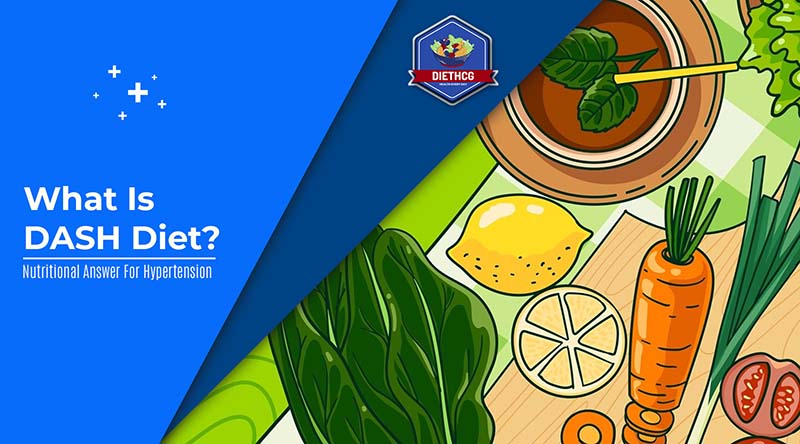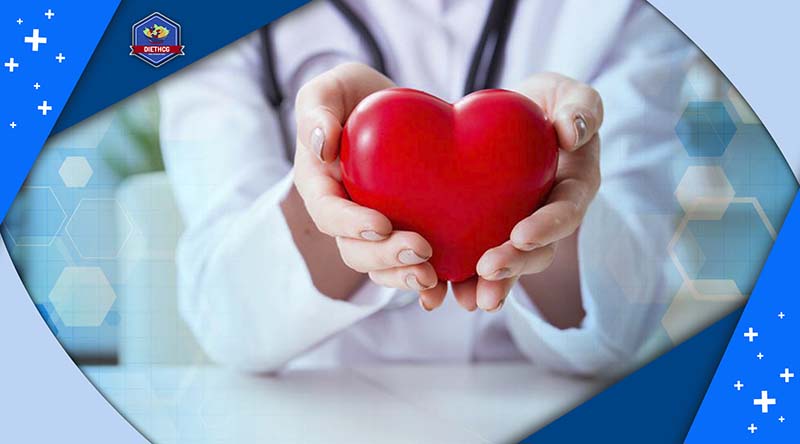Changing your diet can lower your blood pressure as effectively as some medications, and the key player here is the DASH Diet. Our latest blog post, titled “What Is DASH Diet?”, reveals how this dietary approach is making significant strides in fighting hypertension and improving heart health. Discover the game-changing strategy of the DASH Diet and how it encourages a healthier lifestyle and eating habits.

1. What Is the DASH Diet?
The DASH Diet stands for Dietary Approaches to Stop Hypertension. It’s mainly for people who want to lower or manage their high blood pressure and cut down the risk of heart problems.
This diet suggests eating more fruits, vegetables, whole grains, and lean proteins like chicken, fish, and beans. It was made after noticing that people who eat mostly plant foods, like vegans and vegetarians, often have lower blood pressure.
So, the DASH diet is full of fruits and veggies and includes good protein sources while keeping red meat, salt, sugar, and bad fats to a minimum.
A big part of the DASH diet is eating less salt, which is really important for people with high blood pressure. Usually, it suggests eating no more than 1 teaspoon (2,300 mg) of salt a day, which matches what most health guidelines say. There’s even a version that cuts down salt even more, to no more than 3/4 teaspoon (1,500 mg) a day.

Note: When cutting down on salt, do it slowly to get used to the taste and make sticking to the DASH diet easier. Also, getting some exercise can make the diet work even better.
2. Goals and Benefits of the DASH Diet
The DASH Diet, besides helping lower blood pressure, offers several other health benefits, such as aiding in weight loss and decreasing the risk of certain cancers. Though primarily aimed at reducing blood pressure, weight loss can be an additional advantage.
The diet positively affects your body by:
Lowering Blood Pressure: This measures the force of your blood against your blood vessel walls. A normal reading is below 120/80 mmHg. High blood pressure is considered to be 140/90 or higher. The DASH diet has been shown to reduce blood pressure in those with high and normal levels, even without weight loss or severe salt restrictions. Yet, cutting back on salt can drop it even more, especially in those with high blood pressure.
Aiding Weight Loss: While the DASH diet isn’t specifically a weight-loss plan, it can lead to weight loss since it eliminates many high-fat, sugary foods. To lose weight, however, you may need to consciously eat fewer calories.

Other Health Benefits: The DASH diet may also reduce risks of certain diseases, such as:
- Cancer: Following the DASH diet can lower the risk of some types of cancer, like colorectal and breast cancer.
- Metabolic Syndrome: It can significantly reduce the risk of metabolic syndrome, a cluster of conditions that increase heart disease and diabetes risks.
- Diabetes: The diet has been associated with a lower risk of type 2 diabetes and may improve insulin resistance.

- Heart Disease: It could lead to a lower risk of heart disease and stroke, particularly in women.

Eating more fruits and vegetables, as part of the DASH diet, contributes to these protective effects and can help decrease disease risk overall.
3. Salt Intake in the DASH Diet
While reducing salt is a key part of the DASH Diet, cutting back too much can actually be harmful. Eating too little salt has been connected to several health issues like a higher risk of heart disease, insulin resistance, and fluid retention.
The stricter version of the DASH diet suggests limiting sodium to no more than 3/4 teaspoon (1,500 mg) daily. Yet, it’s not totally clear if lowering salt intake to this level is beneficial, even for those with high blood pressure.
Recent studies have shown that while reducing salt intake slightly lowers blood pressure, it doesn’t necessarily correlate with a lower risk of dying from heart disease.
However, many people consume too much salt, often eating between 2 to 2.5 teaspoons (10–12 grams) daily. Lowering your intake to about 1 to 1.25 teaspoons (5–6 grams) might help and is generally more achievable. This reduction is mainly done by eating less processed food and more whole foods.
4. Key Food Groups in the DASH Diet
The DASH Diet focuses on balanced eating from various food groups, depending on your daily calorie needs. Here’s a breakdown based on a 2,000-calorie diet:
- Whole Grains (6–8 servings a day): Include foods like whole-wheat bread, brown rice, and oatmeal. A serving could be a slice of whole-grain bread or 1/2 cup of cooked rice or pasta.
- Vegetables (4–5 servings a day): You can eat all kinds of vegetables. A serving might be 1 cup of raw leafy greens or 1/2 cup of other raw or cooked vegetables.
- Fruits (4–5 servings a day): Enjoy fruits such as apples, berries, and mangoes. One serving could be one medium apple or 1/2 cup of fresh, frozen, or canned fruit.
- Dairy (2–3 servings a day): Choose low-fat options like skim milk or low-fat yogurt. One serving is 1 cup of milk or yogurt, or 1.5 ounces of cheese.
- Lean Meats (6 or fewer servings a day): Opt for lean meats and eat red meat sparingly. A serving is 1 ounce of meat, chicken, or fish, or one egg.
- Nuts, Seeds, and Legumes (4–5 servings a week): This includes foods like almonds, sunflower seeds, and lentils. A serving might be 1/3 cup of nuts or 1/2 cup of cooked legumes.
- Fats and Oils (2–3 servings a day): Prefer vegetable oils and low-fat spreads. One serving could be 1 teaspoon of oil or margarine, or 1 tablespoon of mayonnaise.
- Sweets and Added Sugars (5 or fewer servings a week): Limit intake of sweets and sugars. A serving could be 1 tablespoon of sugar or jelly.
Adjust these servings based on your calorie requirements. Eating a variety of foods from each food group helps ensure you get enough nutrients while managing blood pressure and promoting overall health.
5. Guide to Implementing the DASH Diet
Here is a one-week meal plan based on the DASH diet for someone on a 2,000-calorie per day diet:
Monday:
- Breakfast: Oatmeal (1 cup) with skim milk (1 cup), blueberries (1/2 cup), and fresh orange juice (1/2 cup).

- Snack: Medium apple and low-fat yogurt (1 cup).
- Lunch: Tuna sandwich with whole-grain bread (2 slices), mayonnaise (1 tbsp), green salad (1.5 cups), and canned tuna (3 oz).
- Snack: Medium banana.
- Dinner: Lean chicken breast (3 oz) cooked in vegetable oil (1 tsp) with broccoli and carrots (1/2 cup each), served with brown rice (1 cup).
Tuesday:
- Breakfast: Whole-wheat toast (2 slices) with margarine (1 tsp), jelly or jam (1 tbsp), fresh orange juice (1/2 cup), and a medium apple.
- Snack: Medium banana.
- Lunch: Lean chicken breast (3 oz) with green salad (2 cups), low-fat cheese (1.5 oz), and brown rice (1 cup).
- Snack: Canned peaches (1/2 cup) and low-fat yogurt (1 cup).
- Dinner: Salmon (3 oz) cooked in vegetable oil (1 tsp) with boiled potatoes (1 cup) and boiled vegetables (1.5 cups).

Wednesday:
- Breakfast: Oatmeal (1 cup) with skim milk (1 cup), blueberries (1/2 cup), and fresh orange juice (1/2 cup).
- Snack: Medium orange.
- Lunch: Whole-wheat bread (2 slices), lean turkey (3 oz), low-fat cheese (1.5 oz), green salad (1/2 cup), and cherry tomatoes (1/2 cup).
- Snack: Whole-grain crackers (4) with cottage cheese (1.5 oz) and canned pineapple (1/2 cup).
- Dinner: Cod fillet (6 oz), mashed potatoes (1 cup), green peas, and broccoli (1/2 cup each).
Thursday:
- Breakfast: Oatmeal (1 cup) with skim milk (1 cup), raspberries (1/2 cup), and fresh orange juice (1/2 cup).
- Snack: Medium banana.
- Lunch: Grilled tuna salad with boiled egg, green salad (2 cups), cherry tomatoes (1/2 cup), and low-fat dressing (2 tbsp).
- Snack: Canned pears (1/2 cup) and low-fat yogurt (1 cup).
- Dinner: Pork fillet (3 oz) with mixed vegetables (1 cup) and brown rice (1 cup).
Friday:
- Breakfast: Boiled eggs (2), turkey bacon (2 slices), cherry tomatoes (1/2 cup), baked beans (1/2 cup), whole-wheat toast (2 slices), and fresh orange juice (1/2 cup).
- Snack: Medium apple.
- Lunch: Whole-wheat toast (2 slices), low-fat mayonnaise (1 tbsp), low-fat cheese (1.5 oz), salad greens (1/2 cup), and cherry tomatoes (1/2 cup).
- Snack: Fruit salad (1 cup).
- Dinner: Spaghetti with meatballs made of minced turkey (4 oz), green peas (1/2 cup).

Saturday:
- Breakfast: Whole-wheat toast (2 slices) with peanut butter (2 tbsp), medium banana, mixed seeds (2 tbsp), and fresh orange juice (1/2 cup).
- Snack: Medium apple.
- Lunch: Grilled chicken (3 oz), roasted vegetables (1 cup), and couscous (1 cup).
- Snack: Mixed berries (1/2 cup) and low-fat yogurt (1 cup).
- Dinner: Pork steak (3 oz), ratatouille (1 cup), brown rice (1 cup), lentils (1/2 cup), and low-fat cheese (1.5 oz).
- Dessert: Low-fat chocolate pudding.
Sunday:
- Breakfast: Oatmeal (1 cup) with skim milk (1 cup), blueberries (1/2 cup), and fresh orange juice (1/2 cup).
- Snack: Medium pear.
- Lunch: Chicken salad with lean chicken breast (3 oz), mayonnaise (1 tbsp), green salad (2 cups), cherry tomatoes (1/2 cup), seeds (1/2 tbsp), and whole-grain crackers (4).
- Snack: Banana and almonds (1/2 cup).
- Dinner: Roast beef (3 oz) with boiled potatoes (1 cup), broccoli (1/2 cup), and green peas (1/2 cup).
This plan provides a variety of foods and nutrients aligned with the DASH diet guidelines, aimed at reducing blood pressure and supporting overall health.
6. Conclusion
In conclusion, the DASH Diet, as explored in our “What Is DASH Diet?” segment, presents a proven method for lowering blood pressure and boosting heart health. We’ve detailed the essentials of this diet and its potential to positively transform your life. We’re keen to learn about your personal journeys and insights related to the DASH Diet. Sharing your experiences can inspire us all toward improved health. Remember to check out more engaging blogs from DietHCG for valuable tips, delicious recipes, and deep dives into healthy living. Your path to wellness is merely a click away!


